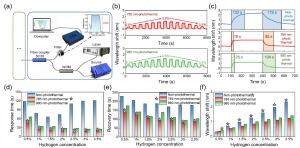
Figure 1. Photothermal synergistic TPP hydrogen detection system integrated at the tip of an optical fiber. (a) A 3D schematic of the fiber-optic TPP tip illuminated simultaneously by a halogen light source (blue beam) and a laser (red beam). (b) Cross-se
Novel strategy for high performance hydrogen sensing
CHENGDU, SICHUAN, CHINA, June 23, 2025 /EINPresswire.com/ — Check out the full article here: https://www.oejournal.org/article/doi/10.29026/oes.2025.240029
Hydrogen, with its high combustion efficiency and environmentally friendly characteristics, has emerged as the most ideal energy source to replace traditional fossil fuels. However, its inherent flammability and explosiveness poses significant safety risks for large-scale, widespread applications, making the development of high-performance hydrogen sensors crucial. Compared to traditional electrical sensors, fiber-optic hydrogen sensors offer intrinsic safety, strong anti-interference capability, and remote detection advantages, demonstrating significant competitiveness in hydrogen detection.
Currently, fiber-optic hydrogen sensing mechanisms primarily include Fabry-Pérot (FP) interferometers, Mach-Zehnder interferometers, conventional or tilted Bragg gratings, and surface plasmon resonance. However, these sensors generally face challenges such as complex fabrication processes, limiting their widespread practical application. In contrast, Tamm plasmon polaritons (TPP) exhibit unique advantages: On one hand, their localized field enhancement effect significantly improves detection sensitivity; On the other hand, their resonance structure can be fabricated simply via thin-film deposition, offering advantages such as simple preparation, low cost, and mass production, paving the way for next-generation high-performance fiber-optic hydrogen sensors. Additionally, while traditional methods primarily rely on material optimization to enhance dynamic response performance, the photothermal effect provides an all-optical auxiliary strategy for rapid detection. However, related research remains in its early stages and requires further exploration.
To address the technical challenges in enhancing the hydrogen detection performance of fiber-optic sensors, a collaborative team led by Associate Professor Yuzhang Liang and Professor Wei Peng from the School of Physics at Dalian University of Technology, along with Professor Ting Xu from Nanjing University, proposed a multi-resonance-coupled, photothermally assisted fiber-optic TPP probe (Figure 1). This design achieves dual synergistic enhancement in both hydrogen detection sensitivity and dynamic response speed.
By leveraging the local field enhancement of TPP, the sensor enables high-sensitivity hydrogen detection, while the high-absorption FP resonance enhances the photothermal catalytic effect, thereby improving the dynamic response speed. This multi-resonance coupling mechanism establishes a new paradigm for designing high-performance fiber-optic hydrogen sensors.
This work reveals the physical mechanism by which the TPP resonance mode achieves higher detection sensitivity compared to the FP resonance mode. The key findings are as follows: The hydrogenation-induced reflective phase shift in the palladium (Pd) film is relatively weak (Fig. 2f). Since the FP resonance mode primarily relies on this phase shift to respond to hydrogen-induced refractive index changes, its resulting sensitivity is limited. In contrast, hydrogenation of the Pd film reduces its reflectivity (Fig. 2e), which decreases the penetration depth of the TPP mode into the Bragg reflector. This leads to a significant shift in the TPP reflective phase (Fig. 2g). Consequently, even with minimal changes in the Pd film’s phase shift, the TPP resonance wavelength exhibits a pronounced displacement, enabling highly sensitive hydrogen detection.
While maintaining high-sensitivity hydrogen detection capabilities, this work achieves crosstalk-free enhancement of dynamic response speed by introducing a laser precisely matched with FP resonance. Thermodynamic theory and experimental results demonstrate that the FP resonance-enhanced photothermal effect improves the response and recovery speeds of the fiber-optic TPP hydrogen sensor by factors of 6.5 and 2.1, respectively, outperforming the photothermal assistance effect under non-resonant conditions.
Consequently, leveraging its unique sensing mechanism and facile-to-fabricate resonant structure, the developed fiber-optic TPP hydrogen sensor not only provides an innovative solution for fiber-optic hydrogen sensing, but also expands the application prospects of multilayer photonic planar structures in emerging fields. Furthermore, the developed multi-resonance-enhanced photothermal synergistic detection system is poised to establish a crucial technological platform for related research field through the interdisciplinary integration of optics and biochemistry.
The research team led by Associate Professor Yuzhang Liang and Professor Wei Peng (Principal Investigator) at the School of Physics, Dalian University of Technology, has long been engaged in the study of plasmonic micro/nanostructures for optical field manipulation, controllable fabrication and fiber integration, as well as the development and application of novel optoelectronic devices. The team has undertaken and presided over more than 20 important research projects, including the National Natural Science Foundation of China (NSFC) Major Research Instrumentation Program, Key Programs, the National Key R&D Program of China, NSFC General Programs, and provincial/municipal major/key Programs. These efforts have yielded numerous innovative research achievements. The team has published over 200 SCI-indexed papers in the fields of micro/nano-optics, optoelectronic devices, and biochemical sensing, featured in internationally renowned journals such as Opto-Electronics Science, Advanced Functional Materials, Advanced Optical Materials, Nanophotonics, ACS Sensors, and Optics Letters. Additionally, the team maintains close collaborations with multiple high-tech companies and hospitals to promote the translation and application of scientific research outcomes.
Andrew Smith
Charlesworth
+44 7753 374162
marketing@charlesworth-group.com
Visit us on social media:
LinkedIn
YouTube
Other
Legal Disclaimer:
EIN Presswire provides this news content “as is” without warranty of any kind. We do not accept any responsibility or liability
for the accuracy, content, images, videos, licenses, completeness, legality, or reliability of the information contained in this
article. If you have any complaints or copyright issues related to this article, kindly contact the author above.
![]()




